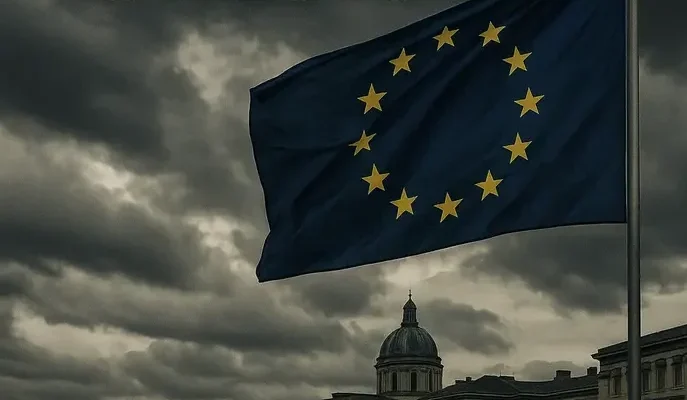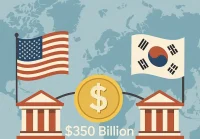Post‑2008, the U.S. and China reflated; Europe chose austerity. Two decades on, the bill is due: Europe’s global GDP share slid from ~20% (2000) to ~14% (2023). Productivity has flatlined, R&D intensity lags (private R&D ~1.2% of GDP vs. ~2% in the U.S.), scaleups migrate, and energy costs remain structurally high.
- Corporate age gap: Europe’s five largest firms average ~100 years old; U.S. peers ~40.
- Talent flight: high‑skill workers exit; replacement via lower‑skill inflows strains welfare systems.
- Policy misfires: Germany’s nuclear exit amid a gas shock undermined industrial competitiveness.
Populism Is A Symptom, Not The Disease
Living‑cost crises and fraying services fueled anti‑establishment gains; populist vote share has roughly tripled since the 1990s. ESG‑linked mandates (e.g., heating rules) met household backlash, while scandals (QatarGate, HuaweiGate) eroded trust. The optics of opaque Commission dealings—think text‑negotiated vaccine contracts—deepened cynicism.
The Euro’s Fault Line
One rate, many economies: France’s total debt load (>350% of GDP across public/private/household) vs. Germany’s (~200%) makes a single policy rate untenable. To stabilize France, the bloc would need years of 6–7% inflation; politically impossible for surplus countries.
Result: de facto renationalization of credit. Governments lean on state‑backed lending and guarantees; banks channel loans to priority sectors; pensions are nudged toward domestic sovereigns—textbook financial repression. Spain/Italy already see near‑total corporate loan growth state‑guaranteed.
France is the pressure point: downgraded credit, >6% fiscal deficit, long yields multiples of COVID‑era lows, revolving governments. The ECB cannot let the Eurozone’s No. 2 economy fail—yet rescuing it risks fragmenting the union further.
Brussels’s Twin Tools: Herd The Savings, Program The Money
- Savings & Investment Union (SIU): funnel household savings (~€10T) into EU‑aligned assets via auto‑enrollment and “patient capital” vehicles, shifting retail money into illiquid SMEs and strategic funds (with caveat‑heavy protections).
- Digital euro (CBDC): framed as modernization and resilience vs. dollar stablecoins; functionally enables holding limits, spending rules, negative rates, and conditional transfers—outsourced to banks but controlled by the Eurosystem.
Together, these direct capital to policy priorities and cushion fiscal gaps if the ECB’s umbrella shrinks.
Markets: What Breaks, What Benefits
Losers (the “naughty step”):
- Leverage‑dependent finance (PE, carry trades), index‑only exposure, and models reliant on ever‑lower rates/spreads.
Winners (policy‑assigned returns):
- Capex tied to defense, energy transition (grid, storage, nuclear restarts where allowed), on‑shoring of critical inputs, transport, and digital infrastructure—often with guarantees, subsidies, or regulated ROEs.
Hedge assets:
- Gold and Bitcoin as censorship‑resistant stores—only with self‑custody. Custodial wrappers sit inside the same policy perimeter.
Markets: What Breaks, What Benefits
The next cycle will reward policy alignment, not just leverage. As rates reset, capital shifts from financial engineering to real infrastructure — defense, energy transition, and critical supply chains. Meanwhile, hedge assets like gold and Bitcoin reemerge as trust hedges, but only outside custodial perimeters. The winners will understand policy direction as much as price action.
Post Jobs & Hire Financial Strategy Talent →Geopolitics: A Looser West, A Pragmatic Europe
With Washington’s commitment wobbling, capitals hedge: softer stances toward China, diversified supply chains, and transactional diplomacy. The bloc looks less like a unified superstate and more like a coalition of fiscally activist nations sharing a brand and a payments rail.
What To Watch Next
1) Overt vs. covert yield‑curve control at national levels (guarantees, captive buyers, regulatory relief).
2) SIU structure: auto‑enrollment mechanics, fee stacks, liquidity locks, and risk transfer to households.
3) Digital euro design: holding caps, offline modes, “conditional payments,” and bank‑mediated programmability.
4) France’s budget path and growth reforms; Germany’s stance on backstopping spreads.
5) Energy resets: nuclear policy pivots, LNG contracts, grid investments, and industrial power pricing.
FAQs
Does this mean the euro collapses?
Not necessarily in name—more likely a long drift toward nationalized credit and soft capital controls. Monetary unity erodes even if the brand persists.
Is austerity coming back?
Less likely. The playbook now favors fiscal activism plus repression—funding priorities via guarantees, captive savings, and regulated returns.
Where is defensiveness most sensible?
Shorter duration quality credit, regulated infrastructure, and real assets with policy tailwinds; minimize reliance on falling rates or passive beta alone.




